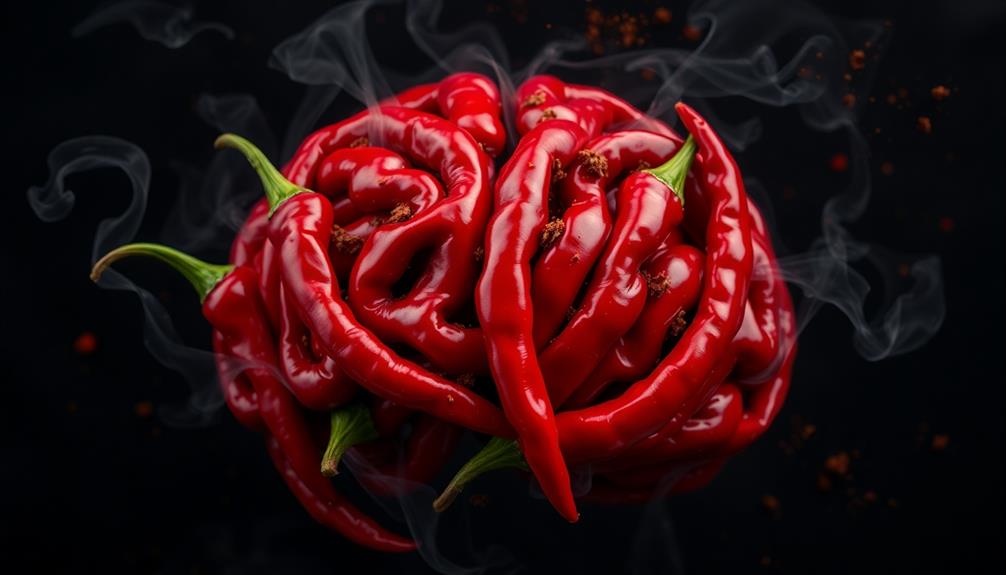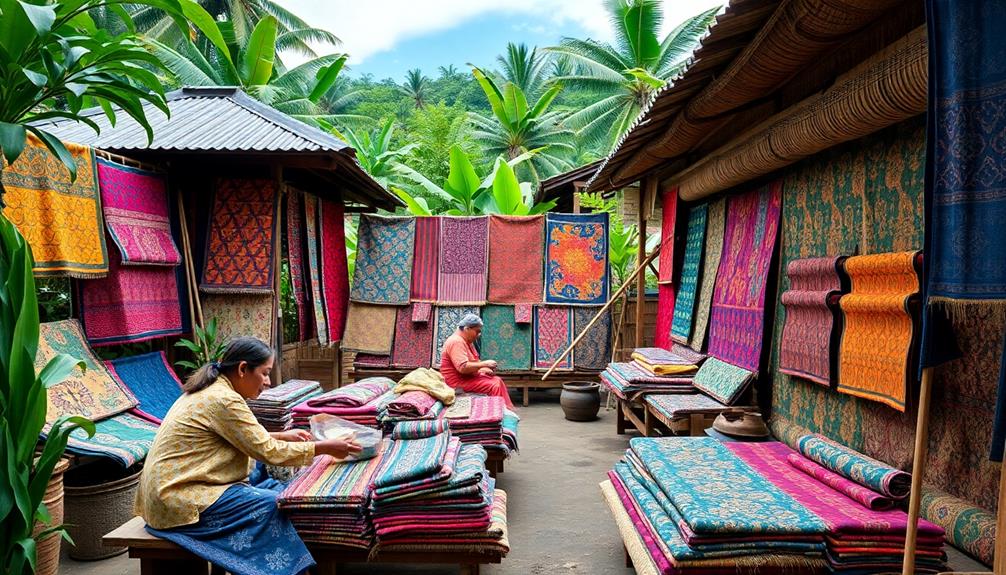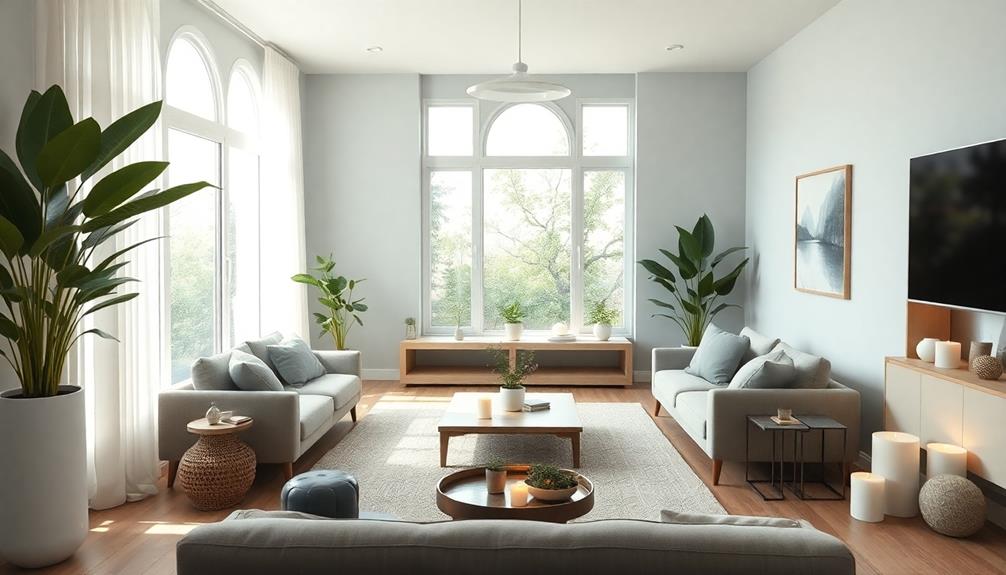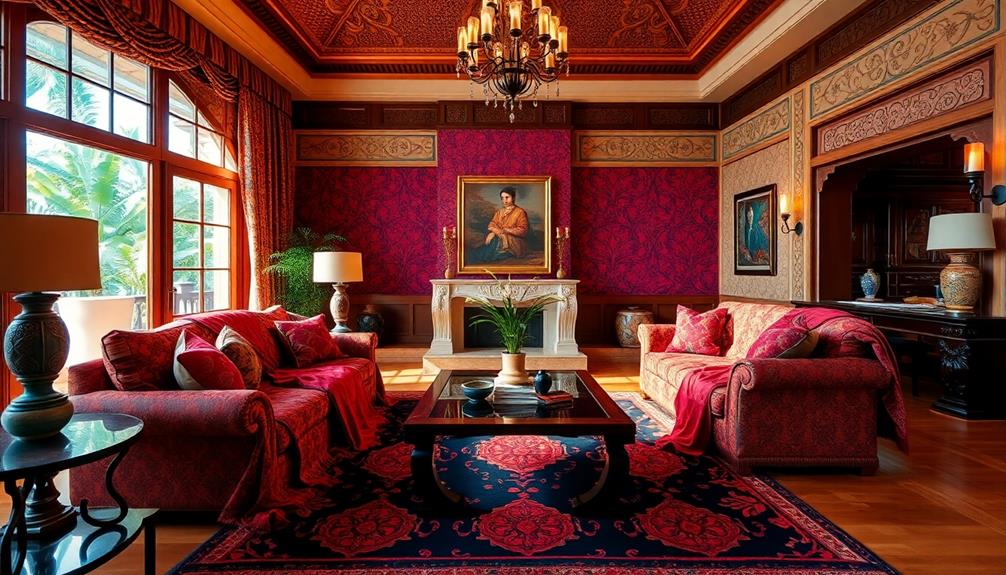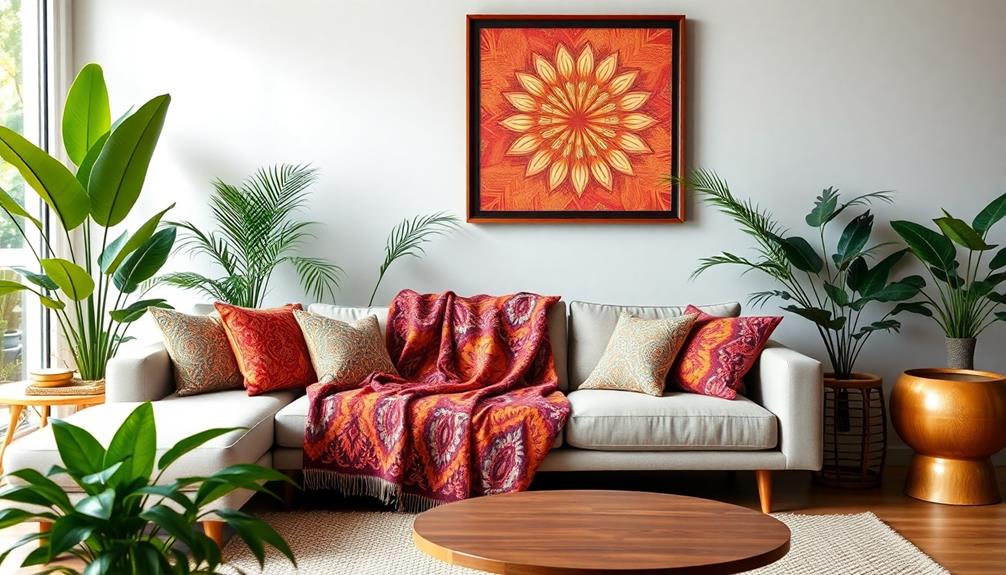To add a unique touch to your interior design with batik, start by selecting vibrant accent pieces like throw pillows, curtains, or wall hangings that showcase its intricate patterns. Pair these with solid colors to create striking contrasts. You can also layer batik textiles with other materials for added depth. Consider using batik for upholstery to infuse your furniture with cultural richness. Remember, proper maintenance is key to preserving batik's vibrant hues. Explore various ways to integrate batik into your decor, and you'll discover how this art form can transform your space while telling a rich cultural story.
Key Takeaways
- Incorporate batik accent pieces like throw pillows and curtains to introduce vibrant colors and intricate patterns into your space.
- Mix batik textiles with solid colors or subtle patterns for a balanced and visually appealing design.
- Utilize batik wall hangings or table runners to add cultural significance and depth to your decor.
- Prioritize high-quality batik fabrics, such as cotton or silk, for durability and longevity in your interior design.
- Regularly maintain batik items by using mild detergents and avoiding direct sunlight to preserve their vibrancy and beauty.
Understanding Batik

Batik is more than just a fabric; it's a rich tradition that traces its roots back to Indonesia. This ancient wax-resist dyeing technique creates intricate patterns and vibrant colors on batik fabrics, making each piece a unique work of art.
You'll find that the process involves applying hot wax to fabric in specific designs, then dyeing the unprotected areas. This method allows for creativity and multiple layers of color, resulting in stunning visuals. Incorporating batik into your home decor can enhance the overall ambiance by adding a touch of traditional elegance and cultural depth, as seen in Indonesian Decorative Pillows.
When you choose batik fabrics for your home, you're not just selecting a decorative element; you're embracing a cultural narrative. Each motif often carries significant meanings, reflecting the rich heritage of its origin.
The durability of batik varies based on the fabric and dyeing techniques used, so it's essential to select wisely to guarantee it fits your intended use.
These fabrics can add an exotic elegance to your space, enhancing everything from throw pillows to curtains. As you explore the world of batik, you'll appreciate how these textiles can transform your home while telling a story that connects you to a vibrant cultural legacy.
Incorporating Batik in Decor
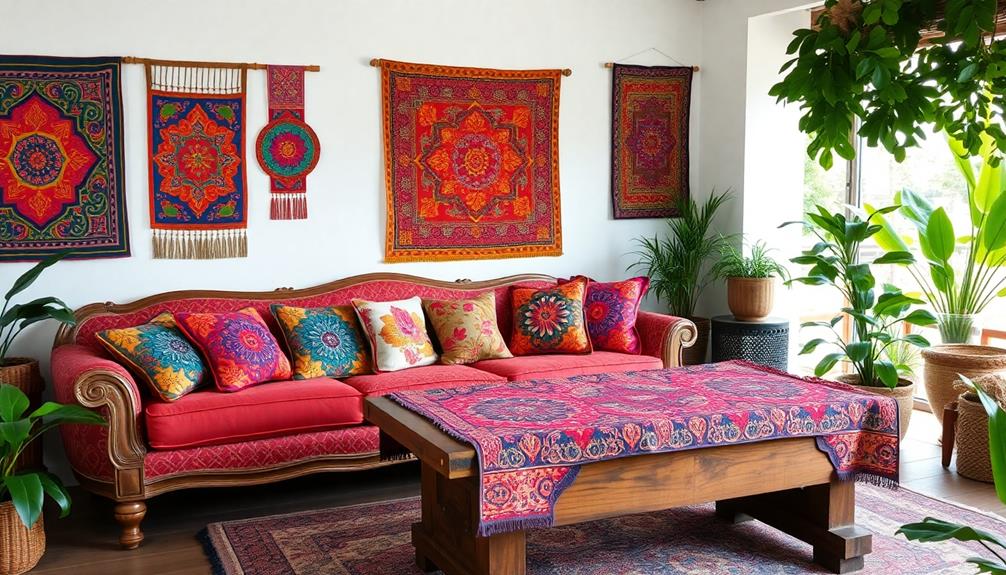
When incorporating batik into your decor, start by selecting accent pieces that showcase its vibrant patterns, which can beautifully complement the intricate carvings found in traditional Indonesian style home decor.
Coordinating the color palette of your batik items with the rest of your space for a harmonious look is essential.
Layering batik textiles with other materials can also create visual interest and depth in your design.
Accent Pieces Selection
The beauty of incorporating batik into your decor lies in its ability to transform ordinary spaces into vibrant, culturally rich environments. When selecting accent pieces, consider how batik fabric can enhance your home. Here are some great options:
| Accent Piece | Description |
|---|---|
| Batik Throw Pillows | Add vibrant color and comfort to your living room, enhancing the overall aesthetic. |
| Batik Curtains | Filter light beautifully while introducing enchanting patterns that serve as a focal point. |
| Batik Wall Hangings | Unique art pieces that reflect your personal style and add texture, blending with various design elements. |
Using batik fabric for upholstered furniture, like accent chairs or ottomans, makes bold statements and sparks conversations. Small accessories, such as table runners or decorative trays, subtly integrate the rich patterns into your space, offering versatility for layering textures and colors. By thoughtfully selecting these accent pieces, you can create a cohesive look that celebrates the beauty of batik while making your home feel uniquely yours.
Color Palette Coordination
Incorporating batik into your decor opens up a world of color possibilities that can breathe life into any space. To achieve effective color palette coordination, start by selecting hues that resonate with the vibrant tones found in batik patterns—think deep blues, rich reds, or earthy shades. These colors can create a cohesive and inviting atmosphere that enhances your design, much like the vibrant artistry of Indonesian decor masks which reflect rich cultural traditions.
Use batik textiles in throw pillows, curtains, or upholstery to introduce dynamic contrasts and intricate designs. Mixing batik with solid colors or subtle patterns allows the striking designs to stand out as focal points. Aim for a balanced distribution of batik elements throughout the room to guarantee they harmonize with your existing color themes.
Be mindful of the scale of batik patterns when coordinating colors; larger patterns can dominate a space, while smaller motifs can accentuate furniture or decor items without overwhelming the room.
Layering With Textiles
Batik textiles provide a fantastic opportunity to layer your decor with vibrant colors and intricate designs. By incorporating batik into your interior, you can create a striking focal point that enhances your overall aesthetic. Additionally, using batik fabric in interiors allows you to celebrate cultural heritage while introducing a touch of global charm to your space. Whether you choose batik for throw pillows, curtains, or wall hangings, the unique patterns offer endless versatility for both modern and traditional styles. By mixing textures and colors, you can create a dynamic and inviting atmosphere reflective of your personal taste.
Start with batik throw pillows on sofas or chairs; they introduce texture and visual interest, allowing for easy updates to your design. Additionally, consider pairing batik with unique pieces like an Indonesian decor mask to further enrich your cultural ambiance, showcasing the rich heritage of Indonesia.
Consider using batik as upholstery fabric for key furniture pieces. This choice transforms traditional or contemporary settings, adding an exotic elegance that captures attention.
To create a balanced look, mix batik with other textiles, such as solids or subtle patterns. This layering with textiles not only highlights the boldness of batik but also brings harmony to your design scheme.
Don't forget to incorporate batik curtains or wall hangings. These elements can add depth and cultural significance to your space, making it feel more personalized and inviting.
With batik, you're not just decorating; you're creating a layered narrative that reflects your unique style. Embrace the versatility of batik textiles and watch your interior design come alive with color and character.
Choosing Batik Fabrics

Selecting batik fabrics for your interior design can transform a space with their vibrant colors and unique patterns. To make the best choices, keep the following tips in mind:
1. Prioritize Quality: Choose high-quality materials like white cotton or silk. These fabrics not only display vibrant colors but also guarantee durability, perfect for your interior design projects.
Additionally, combining batik with culturally rich decor elements, such as Indonesian decor masks, can elevate the overall aesthetic of your space.
2. Consider Color Palettes: The color palette of batik fabrics can greatly influence the mood of your space. Look for shades that complement your existing decor, such as the rich hues found in the Santa Fe Fabric Collection, to create a cohesive look.
3. Embrace Unique Patterns: Each batik fabric carries its own cultural significance through its patterns and motifs. Pay attention to these designs, as they can enhance the storytelling aspect of your decor.
You can also explore using batik fabrics in smaller items like throw pillows or curtains. This approach allows you to subtly integrate exotic elegance into your home without overwhelming the space, while mixing textures adds depth to your design.
Enjoy the artistry of batik fabrics!
Batik for Upholstery

Transforming your furniture with batik upholstery can infuse your space with vibrant colors and intricate patterns, making it a striking focal point.
Balinese design characteristics emphasize the use of cultural elements like textiles, and batik upholstery enhances both traditional and contemporary interiors with its exotic elegance, allowing you to showcase your unique style.
When selecting batik for upholstery, be certain you choose durable fabric bases that can withstand everyday use. It's essential to verify the dyeing process is suitable for heavy use so your pieces will last and maintain their beauty.
The unique wax-resist dyeing technique of batik creates a rich tapestry of colors and textures, perfect for making eye-catching statement pieces or subtle accents in your home decor.
Batik upholstery is versatile, complementing various design styles, which makes it an excellent choice for throw pillows, chairs, and even larger upholstered furniture.
To keep your batik upholstery looking its best, remember to care for it properly. Gentle hand washing or dry cleaning is recommended, along with avoiding harsh chemicals.
Be certain to dry your pieces away from direct sunlight to preserve those stunning colors. By incorporating batik upholstery, you'll elevate your interior design and add a touch of culture to your home.
Creative Batik Accessories

There's something enchanting about incorporating creative batik accessories into your home decor.
These pieces can elevate your space with vibrant colors and intricate patterns, allowing you to express your unique style. For instance, contemplate how batik can reflect Indonesian culture, adding depth to your decor traditional batik patterns.
Here are three fantastic options to ponder:
- Batik Throw Pillows: These pillows can instantly infuse your room with exotic elegance. Choose ones with bold designs to create a striking focal point on your sofa or bed.
- Batik Curtains: Not only do they provide privacy, but they also add a pop of color to your windows. The intricate patterns can enhance the overall aesthetic, making your room feel more inviting.
- Batik Table Runners: These small accessories can serve as subtle yet impactful decor elements. Placing a batik runner on your dining table showcases craftsmanship while adding a touch of culture.
Maintaining Batik Textiles

To guarantee your batik textiles remain vibrant and beautiful, you should regularly maintain them with care. Start by gently hand washing or dry cleaning your pieces, avoiding harsh chemicals and bleach that can fade or damage their intricate patterns.
When you wash them, use mild detergents and skip fabric softeners, as these can affect both texture and coloration. Incorporating sustainable practices in design processes can also extend the life of your batik textiles, as high-quality materials contribute to durability.
It's also essential to dry your batik items away from direct sunlight. Prolonged exposure can lead to color degradation, diminishing their appeal.
Since the durability of batik textiles varies based on the fabric and dyeing process, always choose high-quality materials for upholstery to guarantee longevity.
To further enhance the lifespan of your batik textiles, consider rotating them in your decor. This simple practice helps minimize wear and tear while keeping your interior design fresh and lively.
Mixing Batik Patterns
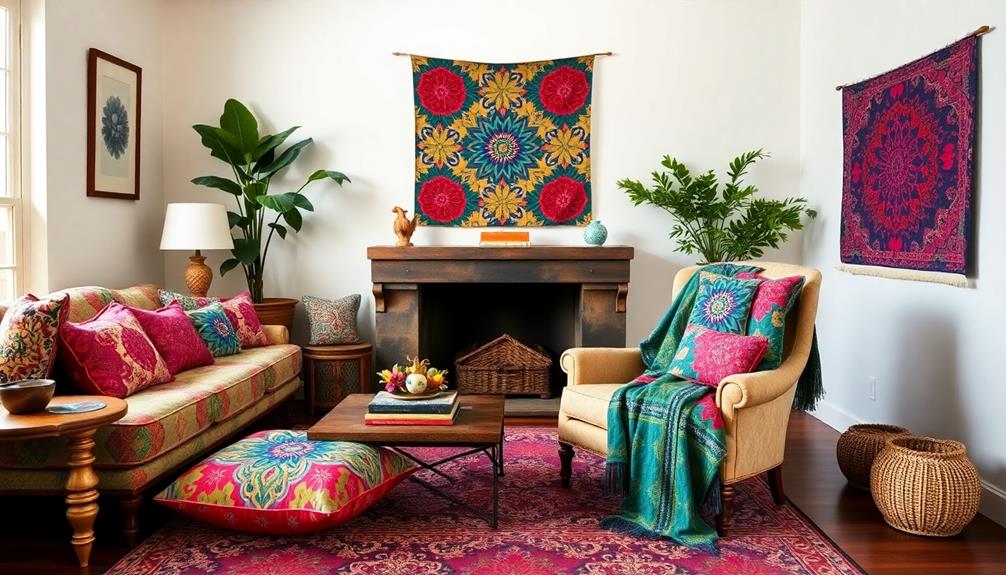
After ensuring your batik textiles are well-maintained, you can explore the exciting world of mixing batik patterns in your interior design. Combining different batik styles can elevate your space, but it's crucial to do it thoughtfully. Start by considering these tips:
1. Cohesive Color Palette: Choose a color scheme that complements your overall design theme. Aim for hues that harmonize rather than clash, allowing the vibrant wax patterns to shine without overwhelming the space.
Incorporating elements from Scandinavian charm in kid-friendly homes can further enhance the warmth and safety of your environment.
2. Scale Matters: Pair larger batik motifs with smaller ones to create visual interest. This balance keeps your design dynamic while avoiding chaos.
3. Layering Textiles: Incorporate batik through various textiles, like throw pillows or curtains. Layering adds depth and showcases the unique characteristics of each pattern, enhancing the overall aesthetic.
You can also mix batik with solid colors or subtle textures to ground the vibrant patterns. Experimenting with traditional, stamped, and painted batik styles will introduce a variety of textures and artistic expressions, adding an eclectic touch to your interior design.
Enjoy the creative process!
Cultural Significance of Batik
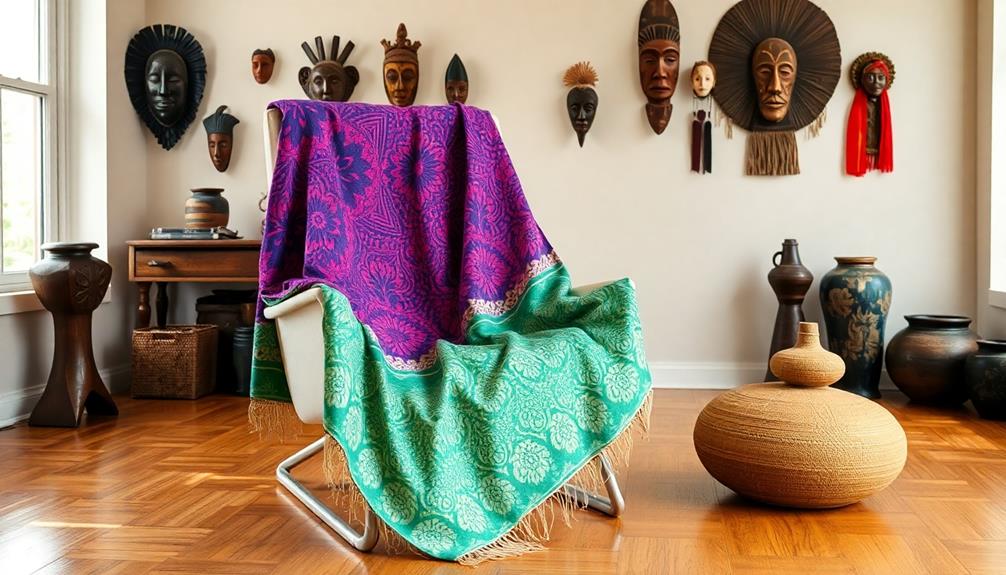
Batik has deep cultural roots that resonate with its wearers and admirers alike. Originating in Indonesia, this intricate art form showcases a wax-resist dyeing technique that dates back thousands of years. Each batik pattern tells a story, often carrying distinct meanings that reflect the cultural significance of the designs. For example, the motif Sido Luhur symbolizes honor and happiness, making it a meaningful choice for your space.
The traditional Indonesian housing, known as "Rumah Adat," often features batik elements, demonstrating the integral role of this art form in local culture and architecture, particularly in its cultural symbolism.
In 2009, UNESCO recognized batik as a Masterpiece of Oral and Intangible Heritage, highlighting its importance in cultural preservation and artisan skills. By incorporating batik into your interior design, you not only beautify your space but also pay homage to its rich history. The motifs often depict local landscapes and cultural narratives, connecting your home to its cultural roots.
As batik evolves, its applications extend beyond clothing to home furnishings, maintaining its relevance in modern design. When you choose batik for your interiors, you're embracing a unique touch that honors tradition while appreciating its global appeal.
This cultural significance can transform your space into a narrative of heritage and artistry, making it feel truly special.
Frequently Asked Questions
What Is the Batik Method of Design?
The batik method of design involves applying wax to fabric to resist dye, creating intricate patterns. Originating from Indonesia, it showcases vibrant colors and meaningful motifs, reflecting cultural significance and artistic expression. It's truly unique.
Why Is Batik a Unique Form of Art?
Imagine intricate patterns whispering tales of culture and history. Batik's uniqueness lies in its rich tradition, painstaking craftsmanship, and diverse regional motifs, each piece a vibrant narrative that connects you to Indonesia's artistic heritage.
What Is Batik in Creative Art?
Batik is a unique art form where you use wax-resist dyeing to create intricate patterns on fabric. It blends traditional techniques with personal expression, showcasing vibrant colors and cultural significance that resonates in contemporary art.
How to Batik at Home?
You'll immerse yourself in a colorful adventure! Start by preparing your fabric, sketching your design, applying wax, dyeing, and finally melting away the wax to reveal your masterpiece. It's a delightful journey of creativity!
Conclusion
By weaving batik into your interior design, you're not just adding color and texture; you're infusing your space with stories and heritage. Imagine vibrant patterns dancing across your walls, evoking the essence of distant lands and rich traditions. Each piece becomes a conversation starter, inviting warmth and curiosity. So go ahead, embrace the beauty of batik, and let your home reflect the unique tapestry of culture and creativity that inspires you every day.


